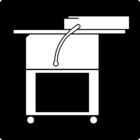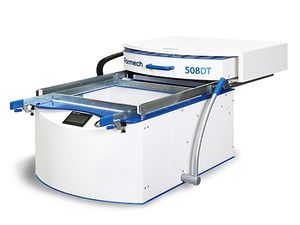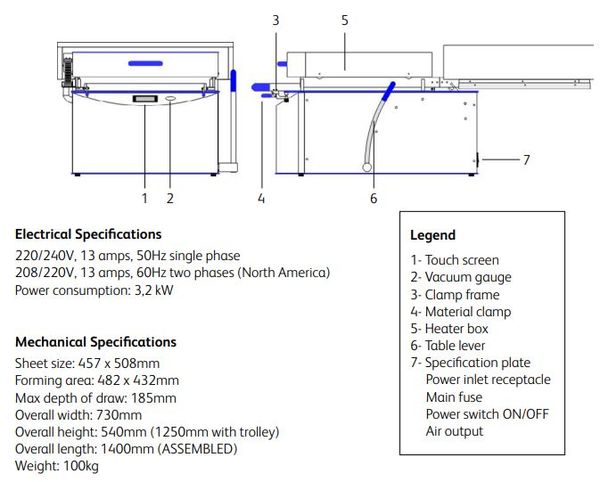Difference between revisions of "Vacuum Former"
| (47 intermediate revisions by 7 users not shown) | |||
| Line 4: | Line 4: | ||
|Is used in domain= | |Is used in domain= | ||
|Has name={{PAGENAME}} | |Has name={{PAGENAME}} | ||
| + | |Has make=Formech | ||
| + | |Has model=508DT | ||
| + | |Has serial number=2728 | ||
| + | |Has life expectancy= | ||
| + | |Has year of manufacture or purchase= | ||
| + | |Has replacement cost= | ||
|Has icon=File:Vacuum Former.png | |Has icon=File:Vacuum Former.png | ||
|Has icondesc= | |Has icondesc= | ||
| Line 10: | Line 16: | ||
|Has imagedesc= | |Has imagedesc= | ||
|Has description= | |Has description= | ||
| − | |Has certification= | + | |Has certification=https://georgefox.instructure.com/courses/1305 |
| − | + | |Has ace=Sara Wytsma;swytsma23@georgefox.edu | |
| − | |||
| − | |Has ace= | ||
}} | }} | ||
| − | [[{{#show: {{FULLPAGENAME}}|?Has icon|link=none}}| | + | [[{{#show: {{FULLPAGENAME}}|?Has icon|link=none}}|140px|left|top|{{#show: {{FULLPAGENAME}}|?Has icondesc}}]] |
[[{{#show: {{FULLPAGENAME}}|?Has image|link=none}}|300px|thumb|upright=1.5|{{#show: {{FULLPAGENAME}}|?Has imagedesc}}]] | [[{{#show: {{FULLPAGENAME}}|?Has image|link=none}}|300px|thumb|upright=1.5|{{#show: {{FULLPAGENAME}}|?Has imagedesc}}]] | ||
Make: {{#show: {{PAGENAME}} |?Has make}} | Make: {{#show: {{PAGENAME}} |?Has make}} | ||
| − | Model: {{#show: {{PAGENAME}} |?Has model}} | + | Model: {{#show: {{PAGENAME}} |?Has model}} |
| + | |||
| + | Serial Number: {{#show: {{PAGENAME}} |?Has serial number}} | ||
Ace: {{#show: {{PAGENAME}} |?Has ace.Has name}} ({{#show: {{PAGENAME}} |?Has ace.Has email address}}). | Ace: {{#show: {{PAGENAME}} |?Has ace.Has name}} ({{#show: {{PAGENAME}} |?Has ace.Has email address}}). | ||
Location: {{#show: {{PAGENAME}} |?Is located in facility}} | Location: {{#show: {{PAGENAME}} |?Is located in facility}} | ||
| + | |||
| + | |||
| + | __TOC__ | ||
==Description== | ==Description== | ||
| − | The Formech 508DT Vacuum Former is a plastic molding machine that utilizes a vacuum to stretch | + | The Formech 508DT Vacuum Former is a plastic molding machine that utilizes heat and a vacuum to stretch heated plastic over a mold. The vacuum former is great for thin plastic molds, although there are some limitations on the shape and size. The max dimensions for the mold are 17”x19” with a depth of 7.3". The max thickness for the plastic sheet is 0.25" Molds can be made from many types of materials. It's fairly common to see molds made from wood. Molds need to have some draft so they can be removed from the plastic. |
| + | |||
| Line 39: | Line 49: | ||
====Terminology==== | ====Terminology==== | ||
| − | * ''' | + | * '''Table-''' The bed that the mold rests on. |
| + | * '''Clamp Frame-''' The metal bars that captivate the plastic sheet as its heated and stretched over the mold. | ||
| + | * '''Toggle Clamp Screws-''' | ||
| + | *'''Draft Angle-''' The wall angle of a mold. This helps in removing the plastic off the mold. | ||
| + | Knowing what the different buttons in the touchscreen operation mean is important in operating the vacuum former. The three primary ones are heat, vacuum, and release. For a full list, refer to the manual. | ||
| − | + | [[Media:Manual-508DT.pdf|Vacuum Former User Manual]] | |
| + | |||
| + | [[Media:Vacuum Forming Guide 200715.pdf|Vacuum Forming Guide]] | ||
==Training== | ==Training== | ||
| − | ==== | + | ====Operation==== |
| + | |||
| + | The vacuum former can mold up to a 19"x17" square and to a depth of 7.3". | ||
| − | + | Molds must slant outwardly slightly to ensure that they can be popped out of the plastic after molding is finished. | |
====Demonstration==== | ====Demonstration==== | ||
| − | + | The demonstration for the vacuum former can use one of the provided demonstration molds or a mold that the trainee brings. The trainee must show that they can set up the vacuum former and mold a part. | |
| − | ==== | + | ====Operation==== |
| − | + | [[File:Formech_Controls.JPG|none|thumb|600x600px]] | |
| − | + | == Operation == | |
| − | + | * Place a mold into the tray and lower it. | |
| − | + | * Mold cannot be concave and must slant outwards slightly or it will not be removable from the plastic. | |
| − | + | * Place plastic into the clamps ensuring it completely covers the white seals. | |
| − | + | * Turn on the heaters and set the temperature. The temperature should be 80-120 degrees Celsius. | |
| − | + | * The heaters should take about 15 minutes to warm up. | |
| − | + | * After 15 minutes roll the heater over the plastic | |
| − | + | * Allow the heater to sit over the plastic for 90 seconds if the plastic is 1.8mm thick or 180 seconds if the plastic is 3.3mm thick. | |
| − | + | * DO NOT OVERHEAT PLASTIC! this will cause the plastic to develop webbing after the vacuum which will ruin the mold. | |
| − | + | * Lift the table. | |
| − | + | * Turn on the vacuum. | |
| − | + | * Let the plastic cool, then hit the release button. | |
| − | + | * Lower the table to remove the plastic. | |
| − | + | * Reset the table. | |
| − | |||
| − | |||
| − | |||
| − | |||
| − | |||
==Safety== | ==Safety== | ||
| − | * | + | * Parts of the machine can reach over 300 degrees C. Don't touch the heater or heat shield surrounding the heater. |
| − | * Never put your hand in a position | + | * Never put your hand in a position it could be pinched by the molding frame. |
| − | * | + | * The formed plastic is very hot and sticky. It could stick to you and continue to burn if you touch it. |
| − | + | * Some types of plastics could give off toxic fumes when heated. Check the SDS before working with materials you are unfamiliar with. | |
| − | |||
| − | * | ||
==Certification== | ==Certification== | ||
| − | + | Complete <strong>The Vault - {{PAGENAME}} Module</strong> at the link below to gain access to the {{PAGENAME}}. The Maker Hub Canvas course pertains to all facilities and equipment contained in the Maker Hub; simply complete the quizzes for the facilities/equipment you wish to use in the Maker Hub. Please email <span style="color:blue">makerhub@georgefox.edu</span> if you have any questions. | |
| + | |||
| + | [https://georgefox.instructure.com/enroll/R6RF69 Maker Hub Canvas Course] | ||
==Troubleshooting== | ==Troubleshooting== | ||
| − | + | Make sure to put draft on your form to prevent sticking. | |
| − | + | If the plastic is not hot enough it won't pull down over the form. | |
| + | If the plastic is too hot then it will develop webbing during the vacuum | ||
==Maintenance== | ==Maintenance== | ||
====General maintenance==== | ====General maintenance==== | ||
| − | |||
| − | |||
| − | |||
| − | |||
====Specific Maintenance Tasks==== | ====Specific Maintenance Tasks==== | ||
| Line 104: | Line 114: | ||
!Done By | !Done By | ||
|- | |- | ||
| − | | | + | |Inspect |
|As Needed | |As Needed | ||
|Ace/Tech | |Ace/Tech | ||
|} | |} | ||
| − | |||
| − | |||
| − | |||
| − | |||
| − | |||
| − | |||
| − | |||
| − | |||
| − | |||
| − | |||
| − | |||
| − | |||
| − | |||
| − | |||
| − | |||
| − | |||
| − | |||
| − | |||
| − | |||
| − | |||
| − | |||
| − | |||
| − | |||
Latest revision as of 15:46, 15 July 2025
Make: Formech
Model: 508DT
Serial Number: 2728
Ace: Sara Wytsma (swytsma23@georgefox.edu).
Location: The Vault
Description
The Formech 508DT Vacuum Former is a plastic molding machine that utilizes heat and a vacuum to stretch heated plastic over a mold. The vacuum former is great for thin plastic molds, although there are some limitations on the shape and size. The max dimensions for the mold are 17”x19” with a depth of 7.3". The max thickness for the plastic sheet is 0.25" Molds can be made from many types of materials. It's fairly common to see molds made from wood. Molds need to have some draft so they can be removed from the plastic.
Here is an example of this piece of equipment being used.
Documentation
Terminology
- Table- The bed that the mold rests on.
- Clamp Frame- The metal bars that captivate the plastic sheet as its heated and stretched over the mold.
- Toggle Clamp Screws-
- Draft Angle- The wall angle of a mold. This helps in removing the plastic off the mold.
Knowing what the different buttons in the touchscreen operation mean is important in operating the vacuum former. The three primary ones are heat, vacuum, and release. For a full list, refer to the manual.
Training
Operation
The vacuum former can mold up to a 19"x17" square and to a depth of 7.3".
Molds must slant outwardly slightly to ensure that they can be popped out of the plastic after molding is finished.
Demonstration
The demonstration for the vacuum former can use one of the provided demonstration molds or a mold that the trainee brings. The trainee must show that they can set up the vacuum former and mold a part.
Operation
Operation
- Place a mold into the tray and lower it.
- Mold cannot be concave and must slant outwards slightly or it will not be removable from the plastic.
- Place plastic into the clamps ensuring it completely covers the white seals.
- Turn on the heaters and set the temperature. The temperature should be 80-120 degrees Celsius.
- The heaters should take about 15 minutes to warm up.
- After 15 minutes roll the heater over the plastic
- Allow the heater to sit over the plastic for 90 seconds if the plastic is 1.8mm thick or 180 seconds if the plastic is 3.3mm thick.
- DO NOT OVERHEAT PLASTIC! this will cause the plastic to develop webbing after the vacuum which will ruin the mold.
- Lift the table.
- Turn on the vacuum.
- Let the plastic cool, then hit the release button.
- Lower the table to remove the plastic.
- Reset the table.
Safety
- Parts of the machine can reach over 300 degrees C. Don't touch the heater or heat shield surrounding the heater.
- Never put your hand in a position it could be pinched by the molding frame.
- The formed plastic is very hot and sticky. It could stick to you and continue to burn if you touch it.
- Some types of plastics could give off toxic fumes when heated. Check the SDS before working with materials you are unfamiliar with.
Certification
Complete The Vault - Vacuum Former Module at the link below to gain access to the Vacuum Former. The Maker Hub Canvas course pertains to all facilities and equipment contained in the Maker Hub; simply complete the quizzes for the facilities/equipment you wish to use in the Maker Hub. Please email makerhub@georgefox.edu if you have any questions.
Troubleshooting
Make sure to put draft on your form to prevent sticking. If the plastic is not hot enough it won't pull down over the form. If the plastic is too hot then it will develop webbing during the vacuum
Maintenance
General maintenance
Specific Maintenance Tasks
| Maintenance Procedure | Frequency | Done By |
|---|---|---|
| Inspect | As Needed | Ace/Tech |


